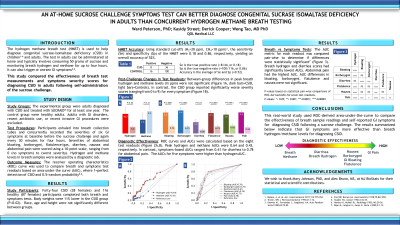Tuesday Poster Session
Category: Functional Bowel Disease
P3381 - An At-Home Sucrose Challenge Symptoms Test (SCST) Can Better Diagnose Congenital Sucrase Isomaltase Deficiency (CSID) in Adults Than Concurrent Hydrogen Methane Breath Testing (HMBT)
Tuesday, October 24, 2023
10:30 AM - 4:00 PM PT
Location: Exhibit Hall

Has Audio
- WP
Ward Peterson, PhD
QOL Medical LLC
Vero Beach, FL
Presenting Author(s)
Ward Peterson, PhD, Weng Tao, MD, PhD, Derick Cooper, BA, Kasidy Street, BA
QOL Medical LLC, Vero Beach, FL
Introduction: A real-world pilot study was conducted in healthy adults and confirmed CSID subjects to compare the diagnostic utility of concurrent measurements of hydrogen and methane levels in breath samples and self-reported severity of GI symptoms following a sucrose load.
Methods: Study participants provided breath samples and reported the severity of six GI symptoms (abdominal bloating, borborygmi, diarrhea, flatulence, nausea, and abdominal pain, based on a 10-point Likert scoring system) immediately before and every 30 minutes for four hours after ingesting dissolved sucrose (50 grams) on an empty stomach. The area-under-the-curve (AUC) derived from the receiver operating characteristic curve (ROC) was used to compare the diagnostic accuracy of both tests for the 44 CSID (true positive) and 116 control (true negative) subjects with both HMBT and SCST data. HMBT AUC was determined using established cut-offs in breath hydrogen or methane levels and compared with a total of 30 AUCs based on change-from-baseline (CFB) severity scores for each of the six symptoms and five timepoints reported from 2 to 4 hr following sucrose ingestion.
Results: The ROC-derived mean AUC for diagnosing carbohydrate malabsorption from the HMBT is 0.52 (95% CI: 0.46-0.59) in this study. In contrast, the mean AUCs derived from the six symptoms and five timepoints post-sucrose challenge were significantly higher (P-values < 0.001 for 26 symptom-timepoints and < 0.05 for all 30 symptom-timepoints). HMBT sensitivity and specificity were 18% and 86%, respectively. In contrast, the highest sensitivity and specificity from the SCST were 82% and 84%, respectively.
Discussion: The hydrogen methane breath test is a gold standard for diagnosis of carbohydrate malabsorption with assay sensitivity, specificity and accuracy that are generally >80% based on in-clinic testing. However, breath tests are frequently self-administered at home without data supporting its diagnostic utility in this setting. The results from this real-world study support the hypothesis that in the absence of medical supervision, GI symptoms are a more sensitive measure of sucrose intolerance associated with CSID than breath hydrogen or methane levels.
Disclosures:
Ward Peterson, PhD, Weng Tao, MD, PhD, Derick Cooper, BA, Kasidy Street, BA. P3381 - An At-Home Sucrose Challenge Symptoms Test (SCST) Can Better Diagnose Congenital Sucrase Isomaltase Deficiency (CSID) in Adults Than Concurrent Hydrogen Methane Breath Testing (HMBT), ACG 2023 Annual Scientific Meeting Abstracts. Vancouver, BC, Canada: American College of Gastroenterology.
QOL Medical LLC, Vero Beach, FL
Introduction: A real-world pilot study was conducted in healthy adults and confirmed CSID subjects to compare the diagnostic utility of concurrent measurements of hydrogen and methane levels in breath samples and self-reported severity of GI symptoms following a sucrose load.
Methods: Study participants provided breath samples and reported the severity of six GI symptoms (abdominal bloating, borborygmi, diarrhea, flatulence, nausea, and abdominal pain, based on a 10-point Likert scoring system) immediately before and every 30 minutes for four hours after ingesting dissolved sucrose (50 grams) on an empty stomach. The area-under-the-curve (AUC) derived from the receiver operating characteristic curve (ROC) was used to compare the diagnostic accuracy of both tests for the 44 CSID (true positive) and 116 control (true negative) subjects with both HMBT and SCST data. HMBT AUC was determined using established cut-offs in breath hydrogen or methane levels and compared with a total of 30 AUCs based on change-from-baseline (CFB) severity scores for each of the six symptoms and five timepoints reported from 2 to 4 hr following sucrose ingestion.
Results: The ROC-derived mean AUC for diagnosing carbohydrate malabsorption from the HMBT is 0.52 (95% CI: 0.46-0.59) in this study. In contrast, the mean AUCs derived from the six symptoms and five timepoints post-sucrose challenge were significantly higher (P-values < 0.001 for 26 symptom-timepoints and < 0.05 for all 30 symptom-timepoints). HMBT sensitivity and specificity were 18% and 86%, respectively. In contrast, the highest sensitivity and specificity from the SCST were 82% and 84%, respectively.
Discussion: The hydrogen methane breath test is a gold standard for diagnosis of carbohydrate malabsorption with assay sensitivity, specificity and accuracy that are generally >80% based on in-clinic testing. However, breath tests are frequently self-administered at home without data supporting its diagnostic utility in this setting. The results from this real-world study support the hypothesis that in the absence of medical supervision, GI symptoms are a more sensitive measure of sucrose intolerance associated with CSID than breath hydrogen or methane levels.
Disclosures:
Ward Peterson: QOL Medical LLC – Consultant, Grant/Research Support, Stock Options.
Weng Tao: QOL Medical LLC – Employee, Stock Options.
Derick Cooper: QOL Medical LLC – Employee, Owner/Ownership Interest, Stock-privately held company.
Kasidy Street: QOL Medical LLC – Employee, Stock Options.
Ward Peterson, PhD, Weng Tao, MD, PhD, Derick Cooper, BA, Kasidy Street, BA. P3381 - An At-Home Sucrose Challenge Symptoms Test (SCST) Can Better Diagnose Congenital Sucrase Isomaltase Deficiency (CSID) in Adults Than Concurrent Hydrogen Methane Breath Testing (HMBT), ACG 2023 Annual Scientific Meeting Abstracts. Vancouver, BC, Canada: American College of Gastroenterology.
